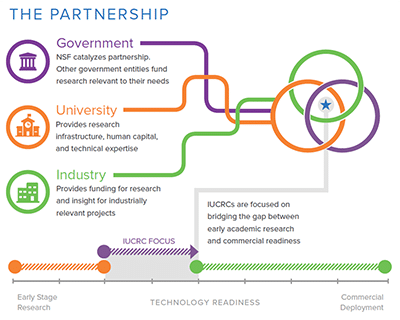By Victoria Scarborough, Ph.D., The ChemQuest Group
University-industry partnerships provide an external source for early-stage technologies that feed the corporate innovation funnel. Long-term strategic research led by industry innovators and academic teams regularly results in pre-competitive technologies, eventually leading to novel commercialized products.
While many companies hire nearby university staff to tackle special projects, engagement with larger academic teams within a specific discipline brings together a stronger, more diverse group of entrepreneurs that can deliver breakthrough innovations.
The National Science Foundation (NSF) supports a program called the Industry-University Cooperative Research Centers (IUCRC) which has a mission to bring industry and multiuniversity academic teams together to conduct impactful research that directly serves industry needs and generates commercialized products.
The IUCRC program has funded centers of excellence throughout the United States formed around emerging research topics. For a fee, industry partners join as members of a consortium to identify and guide research.
Consortium members benefit by accessing knowledge, facilities, equipment, and intellectual property in a highly cost-efficient model while leveraging center research in their own proprietary projects.
Sustained engagement with a center provides industrial partners greater access to pioneering research and scientific talent at a time when corporate research and development budgets are increasingly under pressure and more skilled workers are needed.
There are numerous centers focused on many research areas, but some are directly engaged in subjects of interest to the paint and coatings industry shown below.
Companies that join a center consortium consider it a smart investment toward accessing and influencing cutting-edge research. To learn more about participating in center research, visit www.iucrc.nsf.gov. Envision participation with IUCRC as part of the foundation of a long-term innovation pipeline within your company.◊
Industry-University Cooperative Research Centers
- Center for the Integration of Composites into Infrastructure—accelerates the adoption of polymer composites and innovative construction material into infrastructure and transportation applications
- Center for Advanced Research in Drying—assists U.S. manufacturing industries in becoming more environmentally sustainable by improving the quality of their products using advanced technology in heat/mass transfer processes, such as drying, heating, cooling, freezing, dewatering, and baking
- Center for Atomically Thin Multifunctional Coatings—develops advanced two-dimensional coatings engineered to solve challenges that include corrosion, oxidation and abrasion, friction and wear, energy storage and harvesting, and large-scale synthesis and deposition of novel multifunctional coatings
- Center for Bioplastics and Biocomposites—develops biobased products from agricultural and forestry feedstocks that are compatible with current industrial manufacturing systems, including plastics, coatings, adhesives, and composites
- Center for Science of Heterogenous Additive Printing of 3D Materials—conducts research on different additive printing and manufacturing methods, new material feedstocks, understanding of material properties, and development of new 3D printing methods for novel materials and composites
- Ceramic, Composite, and Optical Materials Center—develops leading-edge ceramic, polymer/ceramic composite, and nano materials and processes
- Concrete Advancement Network (in the planning stages)—enables resilience and sustainability of concrete materials and structures through innovations in materials and processing by leveraging use-inspired research and collaborations
- Center for Translational Innovation in Macromolecular Engineering (in the planning stages)—translates macromolecular engineering processes to industrial relevance to achieve commercial implementation
May 2021 | Vol. 18, no. 5
